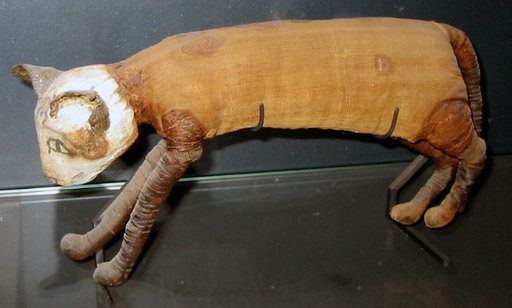Greek Βουβαστειών | ||
 | ||
The Bubasteum was a Ptolemaic and Roman temple complex dedicated to Bastet in the cliff face of the desert boundary of Saqqara. In Arabic the place is called Abwab el-Qotat ("The Gates of the Cats").
Contents
The temple complex is surrounded by a 275 meter wide and 325 metre long enclosure wall and is located southeast of the Pyramid of Teti and south of the Anubieum. It had a large entrance way in the south wall, a feline necropolis and settlements. In the New Kingdom, the location was already the site of a temple of Bastet, who was honoured as the Lady of Ankhtawy.
Proper investigation of the site was begun in 1976 by Alain-Pierre Zivie and the first excavations began in 1980. In 1986, the Mission Archéologique Française du Bubasteion (MAFB), was founded, which has overseen all investigations of the site since then.
Feline necropolis
In the second half of the 18th Dynasty, high dignitaries created Rock-cut tombs for themselves in this area, which were later reused as cat-catacombs. To date, more than a hundred cat mummies and thousands of cat bones have been found. The cat cemetetery developed in the second half of the first millennium BC and, according to Alain Zivie, became as important as the cat cemetery at Bubastis. Traditionally in ancient Egyptian society killing cats was prohibited. However, radiological investigations have shown that the cats in the necropolis died prematurely as the result of a "ritual slaughter," which perhaps could only be carried out by an authorised person from the temple. Two thirds of all the cats could be shown to have been killed by strangulation and many of the rest by smashing the skull. Among the dead cats were many kittens of six to twelve months.
The cats were mummified in two different manners. In the first, the paws and tail were bound close to the body; in the other, the limbs and tail were only partially incorporated, so that the animal continued to appear more as it had when living. Some carefully prepared mummies were found in wooden or stone sarcophagi. Some were even buried with kittens, sculptures, jewelleryand amulets. The mummification procedure was quite basic: the animal was simply dried out; the innards were not removed. Among the mummies discovered were also some "fakes" which were either empty or incomplete. They contained only some bones or inorganic material. The priests perhaps sold pilgrims mummies of varying quality.
In the tomb of Tutankhamun's nurse Maia which was found on the site in 2001, there was a lion skeleton, which had probably also been mummified. The lion was considered a manifestation of the god Maahes, son of Bastet.
Tombs
On the south side of the Bubasteum, near the excavation headquarters of the French mission, is a Steilhang, which contains two levels of tombs. These were created by high officials in the 18th and 19th Dynasties and were plundered in the Late Period. After this they were remodelled and reused for the cat mummies from the nearby sanctuary of Bastet. Two of these tombs were discovered in the early 1980s and the rest have been uncovered more recently. The majority of the graves are carved from the rock face, but some are built of high-value Tura limestone. The decoration is very diverse, often differing significantly within individual tombs. It consists mainly of reliefs, as well as paintings which vary from good to exceptional quality. Many of the items discovered in the tombs, especially those from the tomb of Aperel, are now found in the Imhotep Museum at Saqqara.
List of the tombs in the Bubasteum
The numbering of the tombs is that of the MAFB, in which the tombs of the upper level are numbered with a Roman numeral I and those of the lower level with a II. There is possibly a third level, buried under debris. After the roman numeral, the individual tombs are numbered from east to west with Arabic numerals
